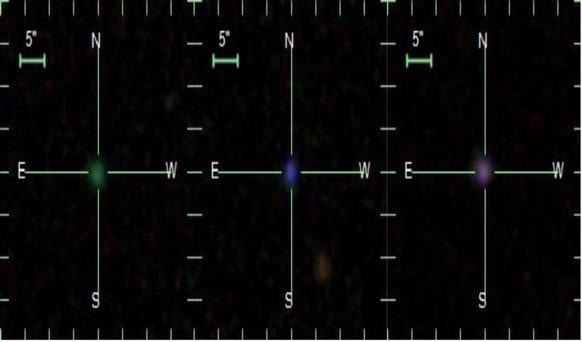A research team comprising Chinese astronomers has spotted 1,547 compact galaxies in the LAMOST DR9. Of which 1,417 were recently discovered and contain a huge collection of Blueberry, Green Pea and Purple Grape galaxies. Up till now, this is the largest collection of new compact galaxies spotted at one time.
 From left to right are images of a Green Pea galaxy, a Blueberry galaxy, and a Purple Grape galaxy. Image Credit: SDSS
From left to right are images of a Green Pea galaxy, a Blueberry galaxy, and a Purple Grape galaxy. Image Credit: SDSS
The astronomers were guided by Ph.D. student LIU Siqi and Prof. LUO Ali from the National Astronomical Observatories of the Chinese Academy of Sciences (NAOC), along with Prof SHEN Shiyin from the Shanghai Astronomical Observatory of CAS (SHAO) and Prof. WANG Junxian from the University of Science and Technology of China (USTC).
The scientists carried out a systematic study of the metallicity, star formation rate, and environment of these galaxies, offering new insight into the creation and development of galaxies in the early universe.
The study results have been published in The Astrophysical Journal.
The Green Pea galaxies were initially detected and given their uncommon name by members of Galaxy Zoo, a project conducted by citizen scientists.
When a team of amateurs categorized the galaxies seen by the Sloan Digital Sky Survey (SDSS) according to their morphology and color, they discovered 251 very special galaxies that could not be straightforwardly categorized according to established galaxy types. These galaxies, which appeared dense and round like beans and seemed green on digital images, were then christened "Green Pea galaxies."
The Green Pea galaxies are approximately 1.5 billion to 5 billion light-years away and are under 1/100 the mass and 1/10 the size of the Milky Way. The robust [OIII] emission lines of the Green Pea galaxies give them a bright green color, which also means that new stars are intensively materializing within.
The Green Pea galaxies possess a high star formation rate in the local universe — a rate around 10 times that of the Milky Way — thus making their masses grow two-fold in a few hundred million years. They also have low metallicity and were probably common in the early universe. Thus, the study of Green Pea galaxies paves the way for comprehending the creation and development of galaxies and star creation in the early universe.
Due to the various positions of the emission lines in the photometric bands, common compact galaxies also include "Purple Grape galaxies" and "Blueberry galaxies" that seem purple and blue, respectively, in pseudo-color images.
The Blueberry galaxies are nearest to the Milky Way and are smaller than Green Pea galaxies, with under 1/3000 the size of the Milky Way. On the other hand, the Purple Grape galaxies are located between the Green Pea and Blueberry galaxies or even past the Green Pea galaxies. The Purple Grape galaxies possess a radius akin to the Green Pea galaxies and a mass under 1/500 of the Milky Way.
All these galaxies are compact and faint, making observation very hard and controlled. Prior to this study, the largest sample of small galaxies with spectral information included only around 800 members.
Based on LAMOST data, this research team spotted 1,417 new compact galaxies, nearly twice as many as formerly known. Among them are 270 Blueberry galaxies, 739 Green Pea galaxies and 388 Purple Grape galaxies — like an "extragalactic fruit and vegetable garden." These recently spotted compact galaxies range in mass from around 310 thousand to 10 billion solar masses, with the most distant galaxies approximately 9 billion light-years away.
By analyzing the spectral line strength of these galaxies, the team learned that their star formation rates are mostly larger compared to the main-sequence star formation rates of other galaxies at the same redshift. The researchers also computed the galaxies' metallicity and verified that these values — which are below those derived in earlier studies — are correct.
Furthermore, the astronomers also learned that these galaxies are more sequestered from each other than other galaxies at the same redshift.
With LAMOST's extragalactic survey ongoing, there is a chance that more compact galaxies like the Blueberry, Green Pea, and Purple Grape galaxies will be spotted, thus rendering it easier to comprehend the creation and development of galaxies in the early universe.
Journal Reference:
Liu, S., et al. (2022) Strong [O iii] λ5007 Emission-line Compact Galaxies in LAMOST DR9: Blueberries, Green Peas, and Purple Grapes. The Astrophysical Journal. doi.org/10.48550/arXiv.2201.04911.